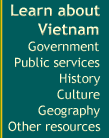Vietnam boasts an age-long and special culture that is closely
attached to the history of the formation and development of the
nation.
Historians have shared a common view that Vietnam has got a fairly
large cultural community that was formed around the first half of the
first millenium before Christ and flourished in the middle of this
millenium. That was Dong Son cultural community. This culture
attained a degree of development higher than that of others at that
time in the region and had its own characteristics but still bore the
features of Southeast Asian culture because of the common South
Asian racial root (Southern Mongoloid) and the water rice culture.
Different development routes of local cultures in various areas (in
the deltas of Hong (Red) river, Ma (Horse) river, Ca
river and so
on...) joined together to form Dong Son culture. This was also the
period of the very "embryonic" state of Vietnam in the form of
inter-
and super-village community, which come into being and existed in
order to resist invaders and to build and maintain dykes for rice
cultivation. From this pattern of "embryo" state, primitive
tribes
grew into nations.
The period of Van Lang-Au Lac culture (lasting for nearly 3,000
years up to the end of the first millenium before Christ) in the early
Bronze Age with 18 Hung kings was regarded as the first apogee in
the history of the Vietnamese culture, which was typified by the
Dong Son bronze drum and stable technique of cultivating water
rice.
The post-Chinese domination period was characterized by the two
parallel trends of Han assimilation and anti-Han
assimilation. The
Dai Viet (Great Vietnam) period was the second apogee of the
Vietnamese culture. Throughout the time of independent feudal
states, milestoned by the Ly-Tran and Le dynasties, the
Vietnamese
culture underwent comprehensive restoration and quick boom,
under the tremendous influence of Buddhism and Taoism.
After the chaotic Le-Mac and Trinh-Nguyen period, when
the
country was separated, and since the Tay Son dynasty reunited the
country and territory, the Nguyen dynasty tried to restore
Confucian culture. They, however, failed because Confucianism had
already been fading and the Western culture started to penetrate
into the country. The period up to the end of French domination
was marked by a cultural mix brought about by two opposite trends
- i.e. of Europeanization and anti-Europeanization; that presents, the
fight between patriotic culture and colonialist culture.
The period of modern Vietnamese culture has gradually taken shape
since the 30’s and 40’s of this century under the banner of
patriotism and Marxism-Leninism. Vietnamese culture, with the
increasingly intensive integration into the world modern civilization
and the preservation and enhancement of the national identity,
promises to reach a new historical peak.
It can be said that there were three layers of culture overlapping
each other during the history of Vietnam: local culture, the culture
that mixed with those of China and other countries in the region, and
the culture that interacted with Western culture. The most prominent
feature of the Vietnamese culture is that it was not assimilated by
foreign cultures thanks to the strong local cultural foundations. On
the contrary, it was able to utilize and localize those from abroad to
enrich the national culture.
The Vietnamese national culture emerged from a concrete living
environment: a tropical country with many rivers and the confluence
of great cultures. The natural conditions (temperature, humidity,
monsoon, water-flows, water-rice agriculture ...) exert a
remarkable impact on the material and spiritual life of the nation, the
characteristics and psychology of the Vietnamese. However, social
and historical conditions exert an extremely great influence on
culture and national psychology. Thus, there are still cultural
differences between Vietnam and other water-rice cultures like
Thailand, Laos, Indonesia, India and so on. Though sharing the
same Southeast Asian cultural origin, the Vietnamese culture was
transformed and bore East Asian cultural characteristics because of
the long domination of the Chinese Han dynasty and the imposition
of its culture on Vietnam.
The Vietnamese nation was formed early in the history and often
had to carry out wars of resistance against foreign invaders, which
created a prominent cultural feature: a patriotism that infiltrated and
encompassed every aspect of life. Community factors with primitive
origin were amalgamated early in the history and became the
foundations for the development of patriotism and national
consciousness. Continual wars were the major cause of the
vicissitudes of the Vietnamese social development history. All the
social and economic structures were often dismantled by wars, so
the social development could hardly reach its peak. Also because of
the destruction of wars, Vietnam has virtually no gigantic cultural
and artistic construction, or if any, they could not have been
preserved intact.
Vietnam boasts 54 ethnicities living across the country. Each
ethnicity has its own cultural colour, thus, the Vietnamese culture is
a diversified unification. Apart from the typical Viet-Muong
culture,
there are other cultural groups like Tay-Nung, Thai, Cham,
Hao-Ngai, Mon-Khmer, H’Mong-Dao, and especially Tay
Nguyen groups that still maintain fairly diverse and comprehensive
traditions of a purely agricultural society that is closely attached to
forests and mountains.











